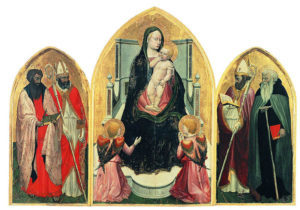Masaccio was born on December 21, 1401 in the Republic of Florence, Italy. He is considered to be the first great painter of the Italian Renaissance. He was skilled at painting life-like figures who not only bore realistic features and proportions, but seemed to move easily and naturally. His ability to capture a sense of three-dimensional space was revolutionary. He was one of the first artists to use linear perspective in his work, so he was quite influential in the lives of many other artists who followed.
Masaccio studied artists such as Giotto. An echo of that artist’s style can be seen in works such as the San Giovenale altarpiece triptych, seen below. The triptych gives us a glimpse of the Virgin Mary holding the child Jesus in her arms, with Saints Bartholomew and Blaise on the left and San Giovenale and Anthony Abbot on the right. We are reminded of Giotto in the way the characters are brought alive in apparent three dimensions, an effect that today we may brush off and take for granted but which in those days would have been much more innovative.
Perhaps Masaccio’s most recognized work and greatest achievement is his Holy Trinity, shown above, painted for the Dominican Santa Maria Novella church in Florence. It is a fresco, which was a style of painting that meant working on a wet surface in a fury before that surface could dry and the pigment could no longer adhere. The piece is notable for its perspective, a technique necessary for a convincing appearance but little understood in that time. The lines in the church ceiling behind Christ’s head come together toward a single point the farther back they recede from the viewer, achieving that accuracy and boldly showing forth its presence in the fresco. The vanishing point (the place all the lines would lead to, if the church went far enough back) was secured by a nail under the cross while Masaccio worked on the piece, and he attached strings as a guideline for the ceiling lines he carved into the plaster. These are still visible in the final piece.
Many other artists of the Renaissance studied Masaccio so that they could understand how to paint well.
Below is shown the San Giovenale altarpiece.

